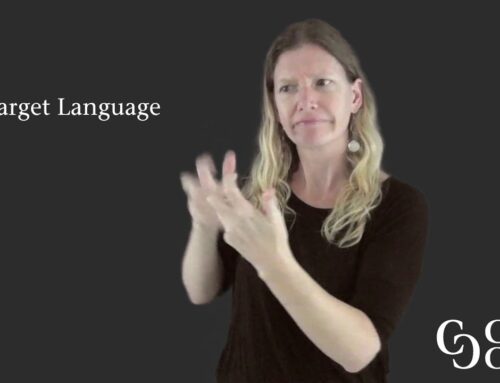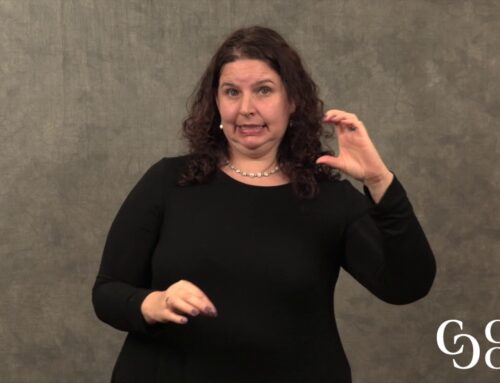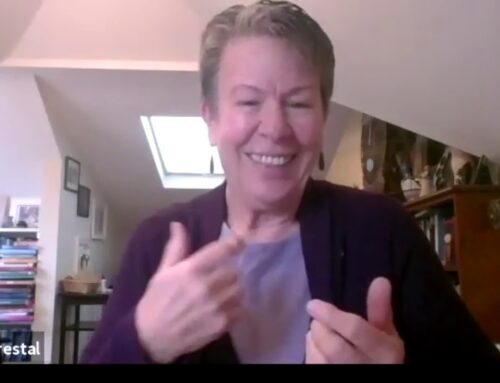 Developed by Mark Halley
Developed by Mark Halley
Competencies Addressed: Message Coherence
Time Required for Activity: 30 mins
Objective: To improve message coherence when interpreting a fast and challenging English text into American Sign Language.
In this video, Dr. Sapna Parikh discusses the process of language acquisition, focusing on second language acquisition for children and adults.
The activity in this post is based on:
Winston, E.A. & Monikowski, C.M. “Discourse Mapping: Developing Textual Coherence Skills in Interpreters” in Roy, C.B., ed. (2000). Innovative practices for teaching sign language interpreters. Washington, D.C.: Gallaudet University Press.
Prediction
You will watch a video in which Dr. Sapna Parikh, a multimedia journalist, explains how children and adults acquire a second language. Considering what you already know about second language acquisition, predict some topics she might discuss, as well as some terms she might use.
Watch the Video
Watch the video in its entirety. Notice that Dr. Parikh speaks rather quickly about a variety of complex topics. To improve your comprehension of how ideas in English are connected together, create a discourse map of Dr. Parikh’s explanation.
Watch source video. (The video will display in a pop-up window.)If you want an example of a discourse map, you can check out this blank map. (The video will display in a pop-up window.)
Check Your Work
Take your own discourse map and compare it with this sample discourse map. Note: the sample discourse map does not include all of the details from the video. Hopefully, it will give you a sense of one possible way of making visual the relationships between the ideas in the text.
In terms of the sample, the blue oval with “Best Age to Learn Second Language” represents the main point of the video. The green shapes at the next level describe the main structure of the text, and then the yellow rectangles share the main units.
If your map captured the majority of the same points and relationships, but looks different, do not worry about the appearance. The point is to pay attention to the relative importance of information and how the ideas are connected together.
After checking your discourse map against the sample, see if you can fill in more information on your own map.
You can watch the video again or review the transcript.
Content Map Example
Source Video
Blank Content Map
Video transcript
Kem cho!
That means “how are you?” in the Indian language Gujarati.
I understand it fluently but I don’t remember learning it at all.
So what the heck happened?
Hey guys what’s up I’m Sapna here for DNews.
Learning a second language is technically referred to as “second language acquisition”.
That’s because acquisition and learning are not quite the same.
ACQUIRING a second language is a subconscious process but LEARNING a language is a conscious process based on formal instruction.
Both are important.
In 1967 linguist and neuroscientist Eric Lenneberg popularized the Critical Period Hypothesis.
It’s a theory that proposed the best age range to acquire a new language.
Lenneberg said the critical period was age 2 to 13- that’s around the age you reach puberty.
Now, this age range is debated by language experts and today they prefer to call it the
“SENSITIVE period” instead of the “CRITICAL period”.
That’s because it’s not SO CRITICAL that you learn a language during THAT TIME period only… it’s actually never too late!
BUT research shows there are advantages to starting early and here’s why…
Kids brains are way better than adults when it comes to LEARNING because of their plasticity – their brains are just better at creating new neural pathways.
It does that through the creation of new SYNAPSES… the connective junctions where one neuron talks to another using electrical and chemical signals. Shortly after birth, synapses form at a rate that’s faster than any other time period in our lives – it’s known as the exuberant period where a young brain can create up to 2 million synapses every second.
The NUMBER of synapses you have peaks between the ages of 4 to 8, but your brain still has a lot of plasticity until puberty.
THAT is why exposure to language at an early age makes such a big difference.
Now… although Lenneberg’s ‘Critical Period’ hypothesis states that that the ideal window to acquire language is age 2 to 13, synapses in the brain’s cortex actually start forming much earlier than that- during the second trimester of pregnancy. And there’s pretty convincing research that shows language development starts before a baby’s even born.. so it’s probably never too SOON for a pregnant mother to speak to
her baby.
And If you are past puberty- don’t worry, it’s not too LATE either… Yea kids brains are more ADAPTABLE and better at making new brain connections but ADULT brains are better at focusing and better at complex thought processes. In fact, adults are FASTER at learning a new language.
SO although kids are better at SUBCONSCIOUSLY acquiring a language .. adults may be better at conscious, systematic, learning.
AND your BRAIN is NOT the only thing that matters. There are external factors like who’s teaching you the language? and are you around native speakers of that language.
And there are internal factors like personality. If you’re outgoing you’re more likely to practice and not be so afraid to make mistakes.
And then there’s motivation – if you enjoy learning a language or if you really want to communicate with a hot new boyfriend or girlfriend.
It sounds cheesy but studies shows you’ll be more successful!
There is a catch to learning a language as adult.
The research shows you’re probably not gonna nail an authentic accent…no matter how hard you try, you’re going to sound like a foreigner.
But that’s ok because did you know that being bilingual could make you smarter?
Trace and Alice explain in this video.
It turns out, those who spoke two languages or more had better cognitive abilities than what was expected based on the intelligence tests they took when they were kids. Now what’s interesting is that even the participants who had learned a second language after the age of 18 had way better results.
Do you speak a second language? Or third or 4th?
If so how did you learn it? And do you have any advice on what worked and what didn’t?
Tell us down in the comments section! Don’t forget to Subscribe to DNews and thanks for watching!




